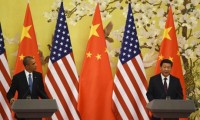President Xi Jinping agrees to cap emissions output and increase use of zero-emission energy sources to 20 percent by 2030.
The Guardian reported on the pledge made by Chinese President Xi Jinping, which was made as part of a “secretly negotiated deal” with US President Barack Obama, who pledged to cut emissions to between 26 and 28 percent below 2005 levels by 2025.
Announced at a joint press conference at the Great Hall of the People, Beijing, the agreement marks the first time that China – the world’s biggest emitter of greenhouse gases – has agreed to cap emissions, having previously “only ever pledged to reduce the rapid rate of growth in its emissions”; with the pledges set to “provide an important boost to international efforts to reach a global deal reducing emissions beyond 2020”, which is expected to be discussed at a UN meeting in Paris next year.
At the press conference, Xi Jinping said: “We agreed to make sure international climate change negotiations will reach agreement as scheduled at the Paris conference in 2015 and agreed to deepen practical co-operation on clean energy, environmental protection and other areas.”
Also speaking at the press conference, Obama said: “As the world’s largest economies and greatest emitters of greenhouse gases we have special responsibility to lead the global effort against climate change. I am proud we can announce a historic agreement. I commend President Xi, his team and the Chinese government for their making to slow, peak and then reverse China’s carbon emissions […] This is a major milestone in US-China relations and shows what is possible when we work together on an urgent global challenge.”
Meanwhile, addressing China’s target to expand energy from zero-emission sources to 20 percent by 2030, a statement from the White House said: “It will require China to deploy an additional 800-1,000 gigawatts of nuclear, wind, solar and other zero-emission generation capacity by 2030 – more than all the coal-fired power plants that exist in China today and close to total current electricity generation capacity in the United States.”
However, Tao Wang, climate scholar at the Tsinghua-Carnegie Center for Global Policy in Beijing, said that the agreement “is a very good sign for both countries and injects strong momentum [into negotiations] but the targets are not ambitious enough and there is room for both countries to negotiate an improvement.
“That figure isn’t high because China aims to reach about 15 percent by 2020, so it is only a five percentage point increase in 10 years, and given the huge growth in renewables it should be higher”.
The Recycler reported in October on research that showed that China’s economic growth is threatening any environmental efforts it has been making in recent years, noting that “carbon efficiency has improved in nearly all Chinese provinces”, but that China’s economic boom has “simultaneously led to a growth in CO2-emitting activities such as mining, metal smelting and coal-fired electricity generation”, which have cumulatively “negat[ed] any gains”.

